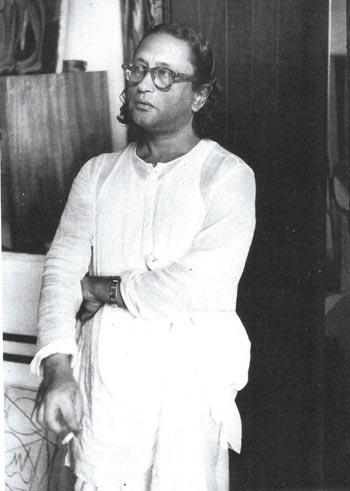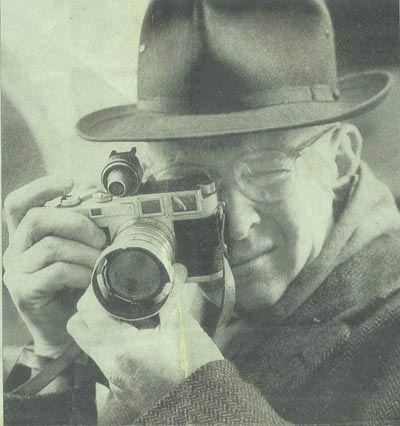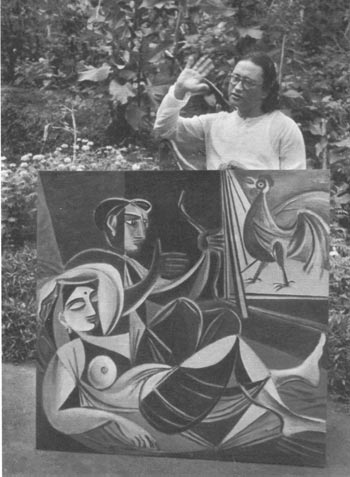Cartier-Bresson’s visit to Ceylon and his studies in portraiture
 Early portraits of the artist George Keyt in his twenties and thirties are very rare. But more so are portraits of Keyt by the eminent French photographer Henri Cartier-Bresson. Cartier-Bresson was on a three-year exploratory journey through Asia amassing images through his camera when he captured Keyt.
Early portraits of the artist George Keyt in his twenties and thirties are very rare. But more so are portraits of Keyt by the eminent French photographer Henri Cartier-Bresson. Cartier-Bresson was on a three-year exploratory journey through Asia amassing images through his camera when he captured Keyt.
Born in 1908, Cartier-Bresson was 40 and at the height of his career when, in1948, he decided to travel to New Delhi. By January that year he was in India. He left Paris in 1947-8 and later journeyed through Ceylon, Burma (Myanmar), Indonesia and China as well. Cartier-Bresson visited India six times, but it was on the 1948 visit that he was right in the centre of controversy.
India had just gained independence in 1947 and Cartier-Bresson was determined to interview Mahatma Gandhi. The day after his first meeting at the end of January tragedy struck with major consequences for the newly independent India. The Mahatma was assassinated following a prayer vigil on January 30,1948. His assassin was Nathuram Vinayak Godse, a former RSS member of an extreme right group and a Hindu fanatic who believed that Gandhi had been too conciliatory to the large Muslim minority.
Bresson was right within the tumult and he continued to take some moving images of the tragic assassination that triggered the killing of hundreds of innocent people. Many of the photographs of the incidents surrounding Gandhi’s death were published in the American magazine Life, which had a global circulation.
The photographer was keen to visit Ceylon and by 1949 – January 18, was corresponding (from Djakarta) with George E. de Silva, father of pioneering woman architect Minnette de Silva and her sister Anil (Mercia). George E. de Silva was a prominent figure as sometime Mayor of Kandy and played a crucial role in the politics of the country. His wife came from the prominent Nell family, and they were all part of the urban elite.

Henri Cartier-Bresson-1957. Photo by Jane Bown
Bresson in his letter noted: “I have the pleasure to know you and I am taking the liberty. My wife and I are friends of Minnette and Anil in Bombay. We heard that Anil is in Bombay. We heard that Anil is still not have her address here (sic)… We are in India, we went to Burma and China.
Wishing to meet up with the de Silva family in Kandy, Cartier-Bresson dispatched another letter to George E. de Silva in response on January 7,1949, in which he stated: “After spending a year in India we went to Burma and China. We are now in Indonesia which is my wife’s country; on our way back home to Paris.”
By March 1950 he was photographing in Ceylon. In January that year he had written to George E. de Silva expressing his intention of visiting this country and also desiring to meet Anil and Minnette- both of whom he had encountered some years ago in Paris and Bombay. Unfortunately, the numerous letters addressed to Minnette’s parents are not wholly reliable and could be interpreted in a number of ways, as Cartier-Bresson’s familiarity with and use of the English language is indistinct and not clear cut.
From Cartier-Bresson’s few photographic images available to us we discover that he travelled to Colombo, Kandy, Amunugama (where Keyt was living), Nittawela, Wariyapola, Polonnaruwa and Adam’s Peak.

Henri Cartier-Bresson’s portraits of the young George Keyt
A keen left-wing supporter, Bresson while here photographed some of the Communist Party’s protests and slogans which appeared as graffiti on the walls of Colombo -appropriately positioned just under the official messages inscribed by the state authorities. Among the images he gifted to the de Silva family is a striking portrait of George E. de Silva taken a few days before he died in 1950.
But the most intriguing images are two portrait studies of George Keyt, both taken around March 1950 near Kandy at the village of Amunugama where Keyt resided with his first wife. Bresson had taken the trouble to travel there 17 miles from the hill capital on a rough, uneven road. The first portrait displays Keyt making some sort of gesture raising his outstretched palm while holding one of his striking paintings. The attached caption states:
Ceylon, March 1950. Village of Amunugama, 17 miles from Kandy. George Keyt, A Burgher, a descendant of the Dutch mixed with Sinhalese, paints with complete awareness of modern theories and techniques. He takes his subjects out of daily life as well as Buddhist and Hindu mythology.
The second portrait also probably taken on the same day is a straightforward full-length pose and shows Keyt in the traditional Indian garb of a plain white kurta and dhoti.
By April 25,1950, Cartier-Bresson was back in Europe and his colleague I. Bondi from Magnum Photos sent a note from London thanking Minnette (or George) and the family for their kindness and hospitality in having entertained Cartier-Bresson and organizing his visits to various interesting locations in Ceylon. Magnum was a body set up by Cartier-Bresson and his colleagues Robert Cap, George Rodger and David Seymour.
Searching for an ideal partner? Find your soul mate on Hitad.lk, Sri Lanka's favourite marriage proposals page. With Hitad.lk matrimonial advertisements you have access to thousands of ads from potential suitors who are looking for someone just like you.


